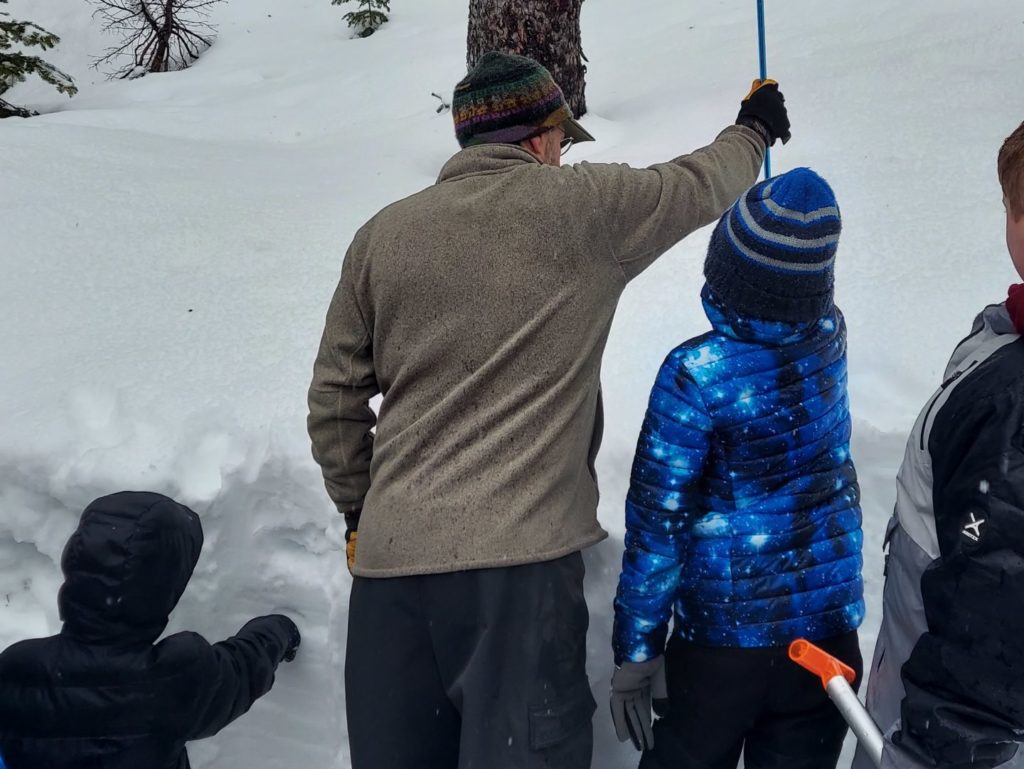“A mind that is stretched by a new experience can never go back to its old dimensions.”
Oliver Wendell Holmes
Where does our water come from? “Why is the snow accumulating in my backyard an important resource for my community?” “What do snowflakes look like, and how do certain snow crystal types impact avalanches?” These are some of the questions fifth graders learn about in the three-day program called SnowSchool.
There is wonder in our backyards, something many take for granted or wish would go away as we impatiently wait for spring to arrive. Yet, there is much to learn and understand about how winter plays into our lives and why snowpack matters as a local natural resource
SnowSchool is a collaboration between – local non-profit Selkirk Outdoor Leadership & Education (SOLE), – Panhandle Alliance for Education (PAFE), and- Lake Pend Oreille School District. It is a place-based experiential education program, meaning kids learn by doing firsthand. As they snowshoe, dig, and examine, they learn about their winter wildlands and the natural systems within these special landscapes.
Open to all 350 (approximately) fifth-grade students in the district, the program involves getting outside on snowshoes to move, explore, learn, and have fun. More than 4300 students have participated since its inception.
SOLE executive director Dennison Webb proposed SnowSchool to LPOSD in 2011, and though they loved the concept, funding was a challenge. Thanks to their supporters, both PAFE and SOLE have been able to fund this program together over the course of the past 12 years. (Consider that next time you see the Backcountry Film Festival, one of SOLE’s primary fundraisers!)
LPOSD educators worked with SOLE to develop a curriculum that is part of the CORE curriculum and adheres to a rigorous E-STEM curriculum. (environmental, science, technology, engineering, math).
On Day One, students learn about watershed science and natural resource concepts in the classroom. Then, on Day Two, they head into the field on snowshoes at SOLE’s Mountain Field Campus, consisting of a 30’ yurt and land generously permitted to operate on by Schweitzer Mountain. This program is open to everyone. To make sure all students have the ability to access this program, SOLE and district employees accommodate those with physical or other disabilities. While in the field, students measure snowpack, collect samples at each layer, and examine the snow through a magnifier and with a crystal card, identifying the snow crystals and taking temperatures and other information.
Here’s a glimpse of our visit on Day 2. We asked the students what surprised them the most:
“My favorite moment is when a student looks through the magnifying loupe for the first time and sees a snow crystal. Their face lights up, and they exclaim, ‘That is so cool!’ It makes all of this worth it,” says Dennison.
Students collect data and record their findings in their field journals. Back in the yurt, SOLE personnel teach them how to synthesize and analyze their data and understand its meaning.
SnowSchool also teaches them an appreciation for winter, how to dress, stay warm and dry, and communicate with others. Our community experiences a lot of winter, and seeing it in a new way helps students appreciate it.
On Day 3, students are back in the classroom, where they further analyze and synthesize their data and compare and contrast their scientific findings to historical trends over 30 years using SNOTEL data. This includes learning to create, utilize, and comprehend a line graph – a fifth-grade math standard.
Educators are encouraged to extend the program in various ways to ensure the learning sticks. They can participate in the Schweitzer Snowpack Prediction Contest to win a classroom pizza party. During the Pend Oreille Water Festival in May, they can further explore their watershed and SnowSchool concepts, like snow water equivalency.
Programs like SnowSchool have the opportunity to spark and ignite a student’s imagination and passion in future pursuits like hydrology, conservation, ecology, or even avalanche forecasting. If nothing else, it will change the way these students think about their relationship with snow and the role it plays in our greater ecosystem next time they are out sledding, making a snowman, or even, dare we say it, daydreaming about the arrival of Spring.
Our teacher grants support Lake Pend Oreille School District educators to bring creative and innovative programs to the classroom. Because they are teacher-led ideas, they have a far more significant impact on the students. These grants fill gaps in funding with innovative programs to amplify our impact. If you’d like to support this, you can donate here.
